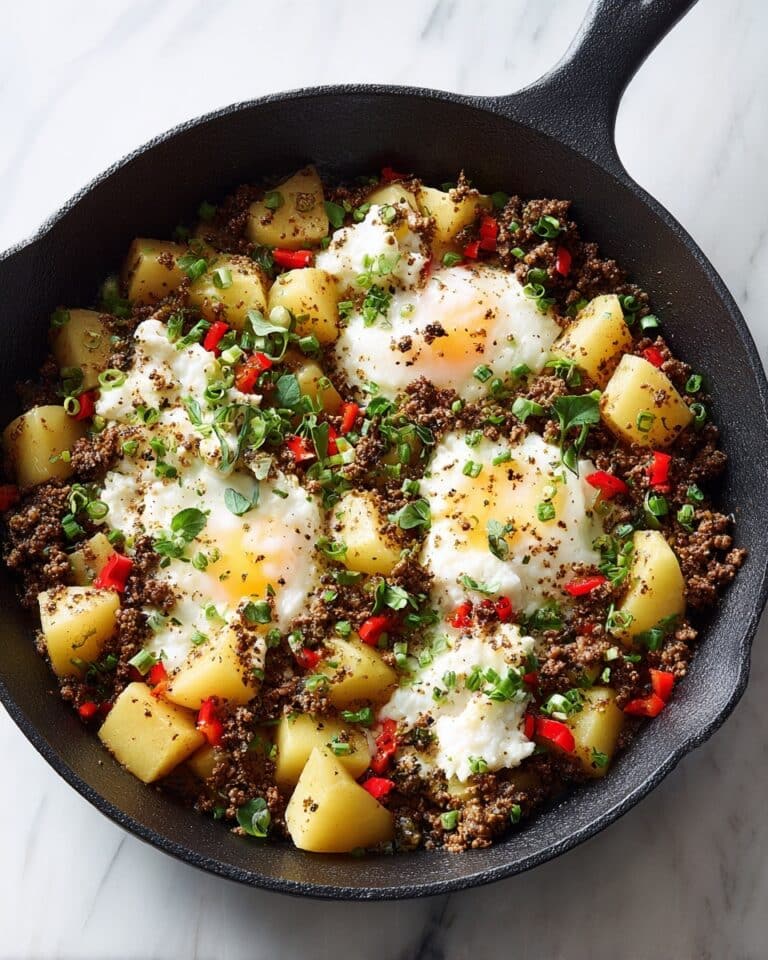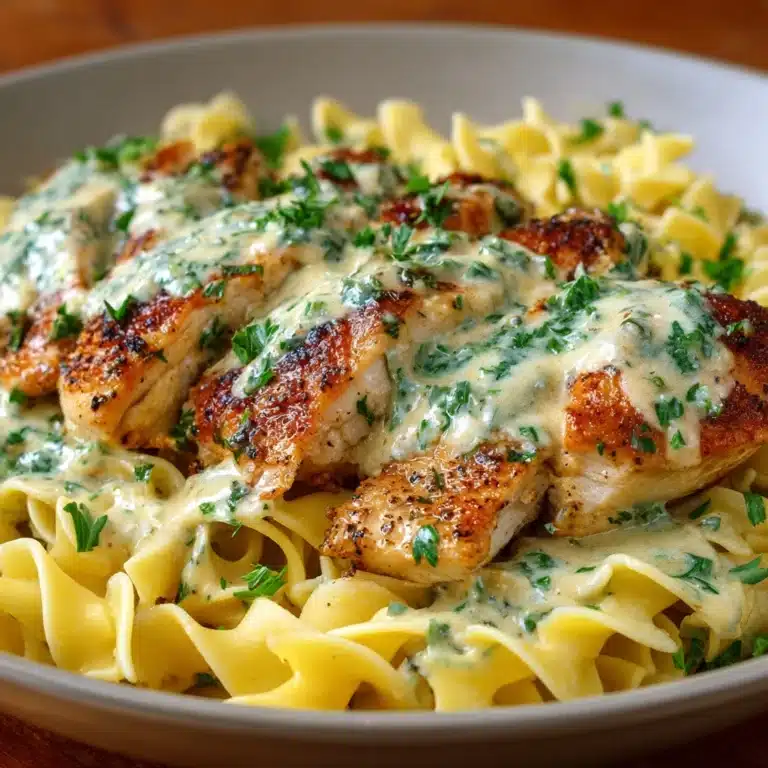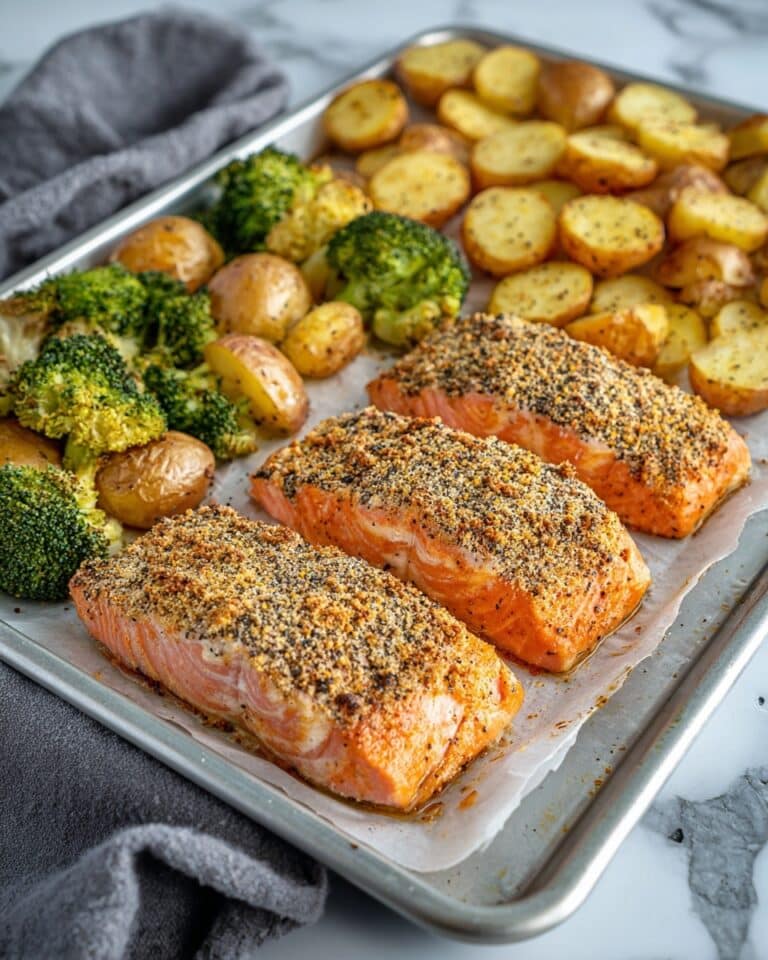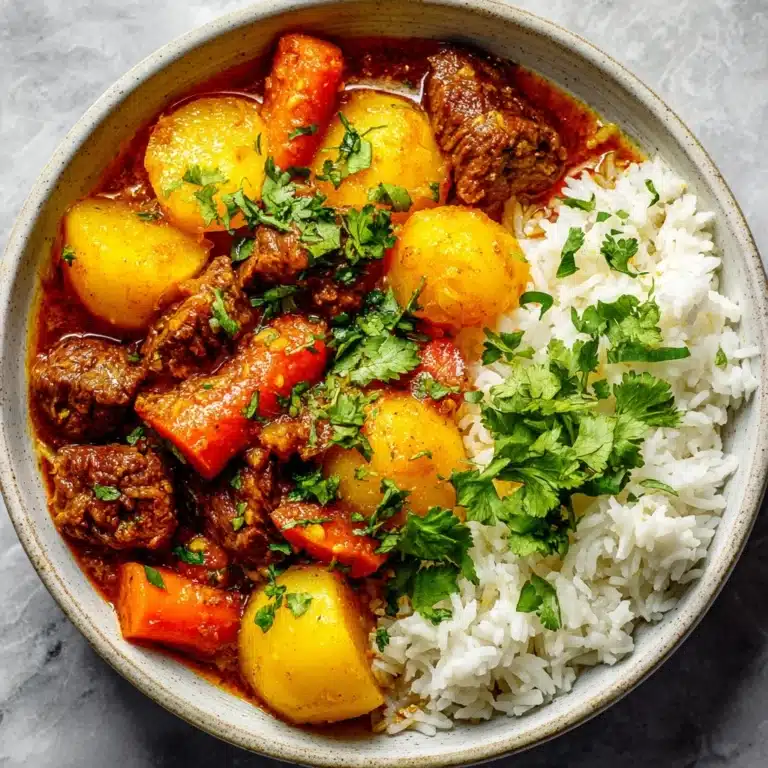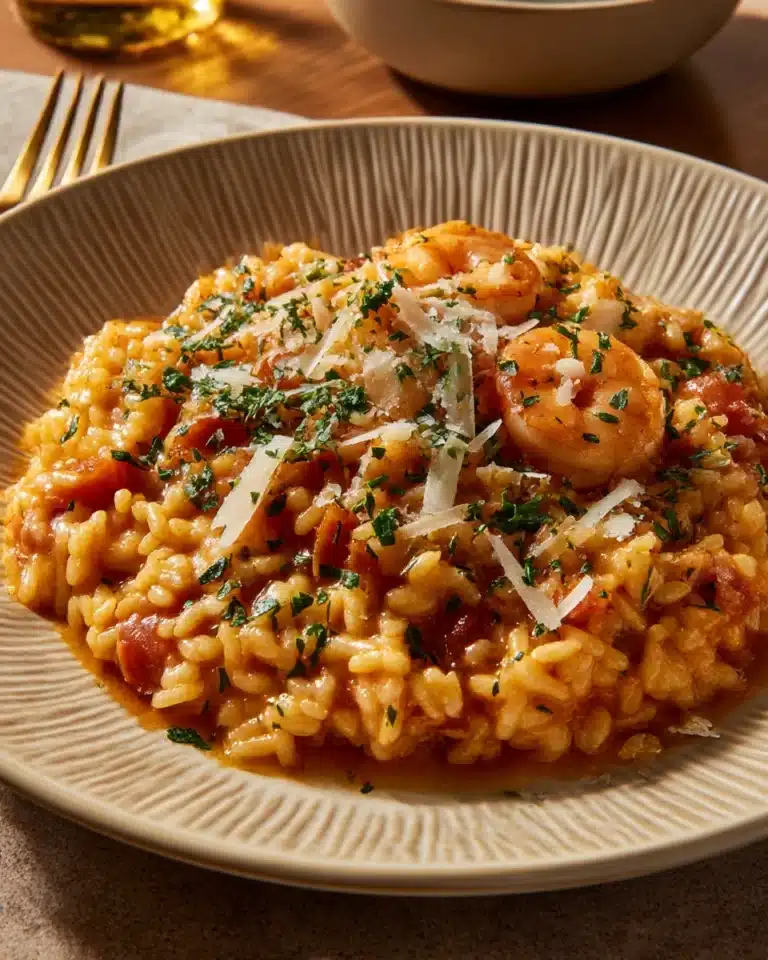Naengmyeon (Korean Cold Noodles) Recipe
If you crave a dish that’s both refreshing and packed with flavor, you’ll fall head over heels for this Naengmyeon (Korean Cold Noodles) Recipe. Imagine perfectly chewy buckwheat noodles swimming in a tangy, icy broth, topped with tender slices of beef, crisp cucumber, sweet Korean pear, and a soft boiled egg. It’s a sensational harmony of textures and tastes that Korean households adore especially on hot days. This recipe isn’t just food; it’s a cooling experience that instantly brightens your meal and transports you straight to the heart of Korea’s vibrant culinary tradition.
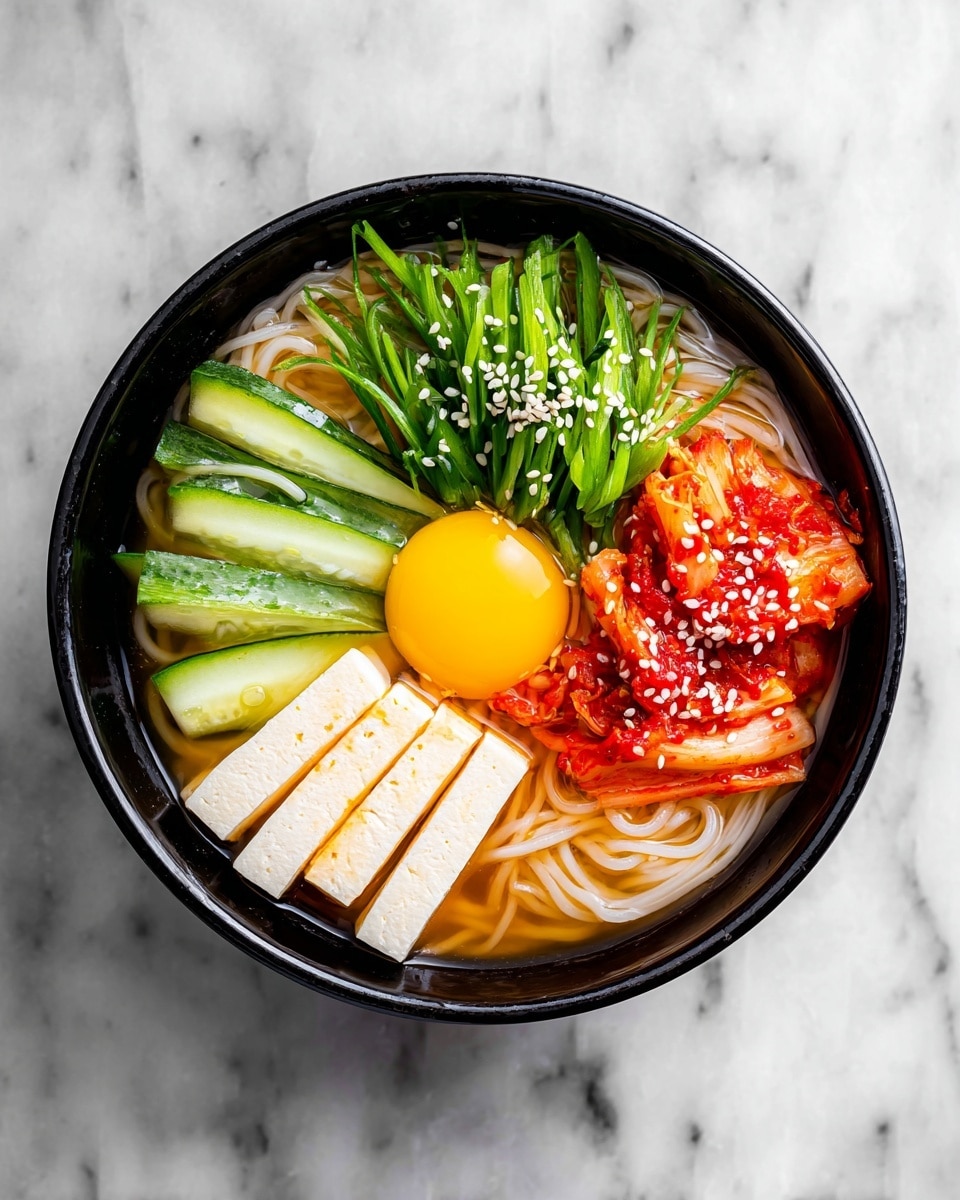
Ingredients You’ll Need
The beauty of this Naengmyeon (Korean Cold Noodles) Recipe lies in its simplicity balanced with depth. Each ingredient plays a starring role, whether it’s enhancing the broth’s zing or adding crisp, fresh texture to every bite.
- Beef broth: Use homemade or low-sodium broth for a rich, clean base that carries the dish’s flavors.
- Dongchimi broth (or cold water): Infuses a subtle tang and refreshing coolness essential for authentic taste.
- Rice vinegar: Adds just the right amount of tang to brighten the broth.
- Sugar: Balances the sourness with a gentle sweetness for harmony.
- Soy sauce: Enhances umami and deepens the flavor profile.
- Cooked beef brisket or flank steak: Thinly sliced, it provides hearty, savory bites amidst the cold noodles.
- Korean pear or crisp apple: Offers a juicy crunch and a touch of refreshing sweetness.
- Cucumber: Julienned for crispness and cool freshness.
- Boiled eggs: Halved, they bring creamy richness and visual appeal.
- Pickled radish or kimchi (optional): Adds tangy spice or mellow pickled notes for those who like a kick.
- Toasted sesame seeds: Sprinkled on top for nutty aroma and subtle texture.
- Naengmyeon noodles: These buckwheat or sweet potato starch-based noodles have the perfect chew and elasticity.
How to Make Naengmyeon (Korean Cold Noodles) Recipe
Step 1: Prepare the Refreshing Broth
Start by blending the beef broth with dongchimi broth (or cold water), rice vinegar, sugar, and soy sauce in a bowl or container. Give it a good stir until the sugar dissolves completely. Place the mixture in your freezer for about 1 to 2 hours, or chill overnight in the fridge if you prefer. The goal is an icy cold broth that’s bursting with balanced tanginess and savory richness without being frozen solid.
Step 2: Cook the Naengmyeon Noodles
Follow the package directions to boil your naengmyeon noodles just until tender but still delightfully chewy. Once cooked, rinse them thoroughly under cold water to stop cooking and to remove starch, which keeps them from sticking. Drain well and if needed, trim the length with scissors for easier eating and presentation.
Step 3: Assemble Your Noodle Bowls
Divide your perfectly chilled noodles between two bowls. Pour the icy cold broth generously over the noodles, allowing the refreshing liquid to envelop every strand. Now comes the fun part—top the noodles with thinly sliced cooked beef, crisp cucumber, sweet Korean pear slices, half a boiled egg, and optional pickled radish or kimchi for a pleasing kick. Finish with a sprinkle of toasted sesame seeds to add that irresistible nutty hint.
How to Serve Naengmyeon (Korean Cold Noodles) Recipe
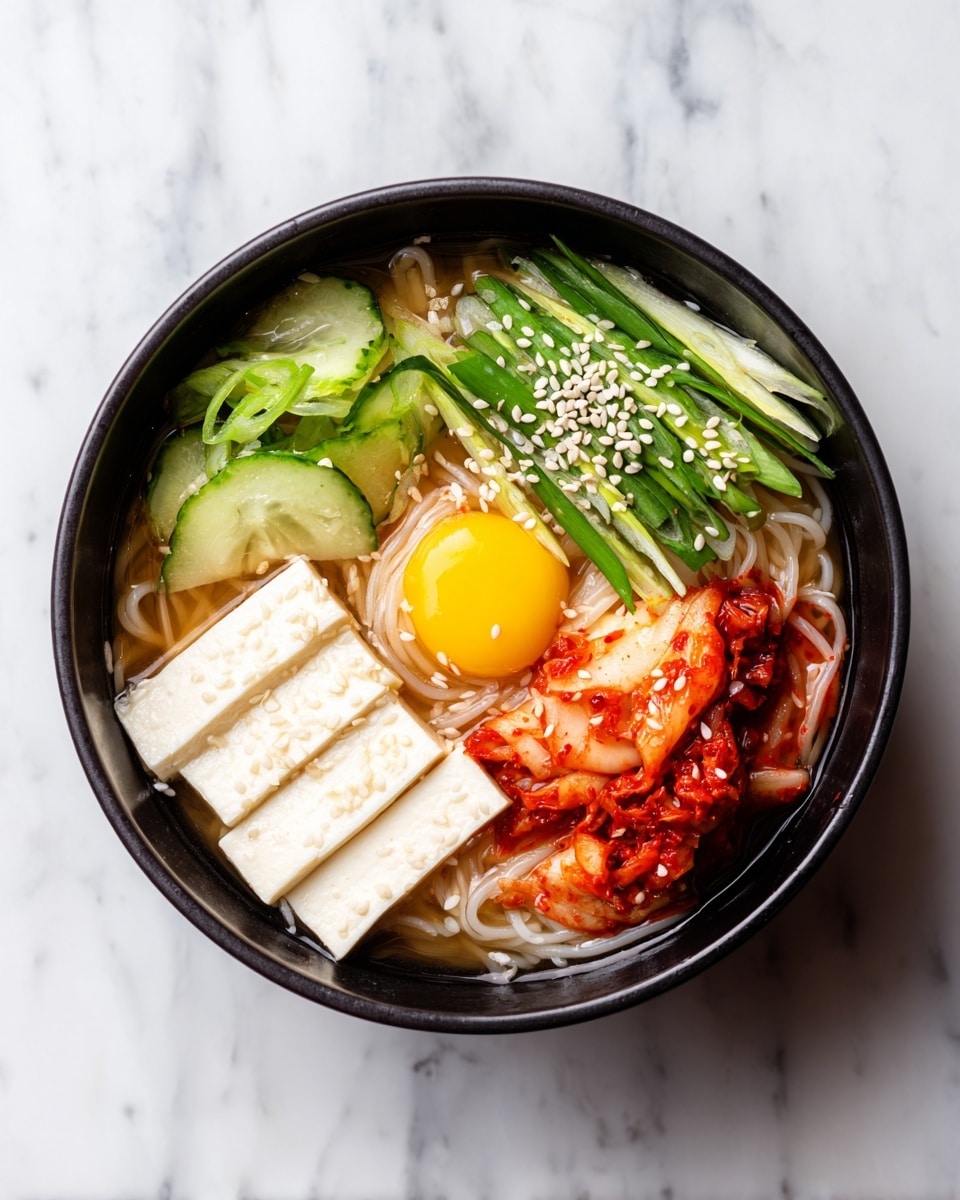
Garnishes
Garnishing is more than decoration; it enhances taste and texture. Fresh julienned cucumbers and thinly sliced Korean pear create a cool crunch that complements the chewy noodles. The boiled egg adds a creamy richness, and nutty toasted sesame seeds bring an aromatic finish. For an adventurous twist, serve with a side of gochujang or a splash of mustard vinegar to let your guests customize their flavors.
Side Dishes
Naengmyeon pairs beautifully with classic Korean sides like kimchi, seasoned spinach, or pickled radishes. These sides offer spicy, salty, or tangy contrasts that elevate the cool calmness of the noodles. A simple bowl of steamed rice or grilled meats can also make a fulfilling meal alongside this cooling star dish.
Creative Ways to Present
Try serving the Naengmyeon (Korean Cold Noodles) Recipe in clear glass bowls to showcase the vibrant colors of the toppings and the crystal-clear broth. You can also add ice cubes into the broth for extra chill on sweltering days. For a fun touch, arrange the toppings in neat sections or artfully scatter toasted seeds and thin green onion curls on top for fresh aroma and visual wow-factor.
Make Ahead and Storage
Storing Leftovers
Place any leftover noodles and broth separately in airtight containers in the refrigerator. The noodles may toughen slightly after refrigeration, so it’s best to consume within 1 to 2 days for optimal texture and flavor.
Freezing
Freezing is not recommended for this Naengmyeon (Korean Cold Noodles) Recipe because the texture of the noodles and the delicate broth can degrade significantly after thawing, resulting in a watery broth and mushy noodles.
Reheating
This dish is designed to be enjoyed cold. If you want to warm leftover beef toppings, gently reheat them separately. The noodles and broth should be served chilled for that quintessential mouthwatering experience.
FAQs
Can I use store-bought broth for this recipe?
Absolutely! Pre-packaged beef broth or even ready-made naengmyeon broth from Korean stores are convenient substitutes. Just adjust vinegar and sugar to balance tang and sweetness according to your preference.
What noodles work best for naengmyeon?
Traditional naengmyeon noodles are made from buckwheat or sweet potato starch, giving them their iconic chewy texture. You can find them in Korean or Asian markets, and it’s worth seeking authentic noodles for the best experience.
Is this dish spicy?
The traditional Naengmyeon (Korean Cold Noodles) Recipe is not spicy but rather refreshingly tangy and savory. However, you can spice it up with a dollop of gochujang or sides like mustard sauce if you love some heat.
How long does the broth need to chill?
For the best flavor and temperature, chill the broth for at least 1 to 2 hours in the freezer or overnight in the refrigerator. It should be very cold but not completely frozen to maintain the perfect consistency.
Can I prepare this recipe for more people?
Definitely! Just multiply the ingredients proportionally and prepare the broth in larger batches. Naengmyeon noodles cook quickly, making it a perfect dish for summer gatherings.
Final Thoughts
This Naengmyeon (Korean Cold Noodles) Recipe is a delightful journey through textures and flavors that never fail to refresh and satisfy. Whether you’re new to Korean cuisine or a longtime fan, this dish offers a wonderful way to cool down and energize your taste buds. Give it a try, and I promise it will become a cherished favorite on your table all summer long.
Print
Naengmyeon (Korean Cold Noodles) Recipe
- Total Time: 25 minutes (plus chilling time)
- Yield: 2 servings 1x
- Diet: Low Fat
Description
Naengmyeon is a classic Korean cold noodle dish featuring chewy buckwheat noodles served in a chilled, tangy broth with sliced beef, pickled radish, cucumber, and a boiled egg. Refreshing, savory, and slightly sweet, it’s perfect for hot days and is a staple in Korean cuisine—especially enjoyed during the summer months.
Ingredients
For the Broth:
- 3 cups beef broth (preferably homemade or low-sodium)
- 1 cup dongchimi (Korean radish water kimchi) broth or cold water
- 1 tablespoon rice vinegar
- 1 tablespoon sugar
- 1 teaspoon soy sauce
For the Toppings:
- 4 ounces cooked beef brisket or flank steak, thinly sliced
- ½ Korean pear (or crisp apple), peeled and thinly sliced
- ½ cucumber, julienned
- 2 boiled eggs, halved
- Pickled radish or kimchi (optional)
- Toasted sesame seeds
For the Noodles:
- 9–10 ounces naengmyeon noodles (buckwheat or sweet potato starch-based, found in Korean markets)
Instructions
- Prepare the Broth: In a bowl or container, combine the beef broth, dongchimi broth (or cold water), rice vinegar, sugar, and soy sauce. Stir well until the sugar dissolves completely.
- Chill the Broth: Place the broth mixture in the freezer for 1–2 hours to get very cold but not frozen, or refrigerate it overnight. This chilling step is essential for serving naengmyeon authentically cold and refreshing.
- Cook the Noodles: Bring a pot of water to a boil and cook the naengmyeon noodles according to package directions, usually around 3-5 minutes. Once cooked, immediately rinse the noodles under cold running water to stop cooking and remove excess starch. Drain thoroughly.
- Prepare the Toppings: While the broth chills, thinly slice the cooked beef brisket or flank steak, julienne the cucumber, and slice the pear. Boil eggs ahead of time, peel, and cut in halves.
- Assemble the Dish: Divide the drained noodles evenly into two serving bowls. Pour the icy cold broth over the noodles. Arrange the sliced beef, cucumber, pear, boiled egg halves, and optional pickled radish or kimchi on top.
- Garnish and Serve: Sprinkle toasted sesame seeds over each bowl for added flavor and a slight crunch. Serve the naengmyeon immediately to enjoy its refreshing cold texture and vibrant flavors. Optionally serve with mustard or vinegar on the side for added zest.
Notes
- You can use pre-packaged naengmyeon broth from Korean grocery stores for convenience.
- Adjust the sweetness and tanginess of the broth to your preference by adding extra sugar or rice vinegar.
- For a spicier twist, incorporate a spoonful of gochujang (Korean chili paste) into the broth or serve it alongside.
- Cut noodles with kitchen scissors if they are too long for easier eating.
- Prep Time: 15 minutes
- Cook Time: 10 minutes
- Category: Main Course
- Method: No-Cook
- Cuisine: Korean
